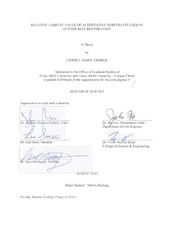| dc.description.abstract | Oyster reef habitats have declined from historic levels due to a variety of reasons, including overharvest, disease, and degraded water quality. The harvesting of oysters has led to a loss of reef habitat for both oysters and reef-associated fauna. When oysters spawn, the larval oysters, or spat, depend on hard substrate for settlement and growth. Oyster shell is the preferred substrate for use in restoration because it most closely matches natural reef habitat, but it is often expensive and in limited supply. This study incorporated field and laboratory experiments to assess the relative habitat value of alternative substrates (crushed concrete, porcelain, crushed limestone, and river rock, as well as oyster shell) for larval oyster recruitment as well as reef resident fishes and macro-invertebrates. Replicate trays of each substrate type were deployed in St. Charles Bay, TX for four months during spring and summer 2012 and assessed for oyster recruitment and faunal diversity and density. Concrete, river rock, limestone and porcelain had similar spat recruitment densities compared to oyster shell (1300-2300 spat). Spat shell heights were also larger on these substrates (13-16 mm), while spat on porcelain substrates were slightly smaller (10-13 mm). All substrates except bare sediment had similar fauna species densities (200-500 individuals m-2). Limestone had lower fauna diversity (H’; 0-1) than concrete and shell (1-2). Laboratory experiments compared the effectiveness of these substrates in providing prey refuge from pinfish and blue crab predators. All substrates performed similarly resulting in very low (<20 %) prey mortality rates for either predator. Results may enable future restoration plans to be implemented at a lower cost while providing similar habitat functions. | en |


